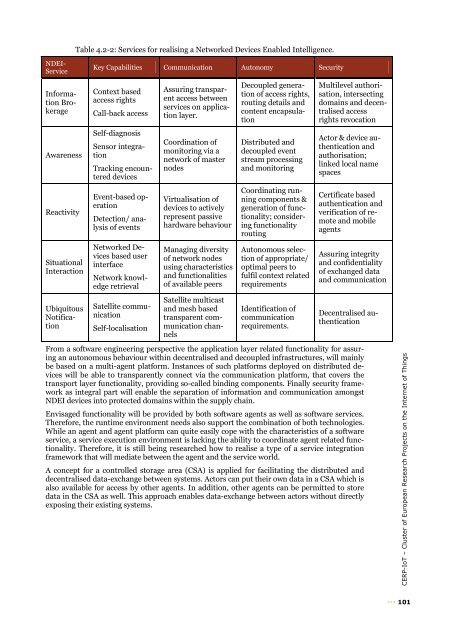Vision and Challenges for Realising the Internet of Things
Vision and Challenges for Realising the Internet of Things
Vision and Challenges for Realising the Internet of Things
Create successful ePaper yourself
Turn your PDF publications into a flip-book with our unique Google optimized e-Paper software.
NDEI-<br />
Service<br />
In<strong>for</strong>mationBrokerage<br />
Awareness<br />
Reactivity<br />
Situational<br />
Interaction<br />
Ubiquitous<br />
Notification<br />
Table 4.2-2: Services <strong>for</strong> realising a Networked Devices Enabled Intelligence.<br />
Key Capabilities Communication Autonomy Security<br />
Context based<br />
access rights<br />
Call-back access<br />
Self-diagnosis<br />
Sensor integration<br />
Tracking encountered<br />
devices<br />
Event-based operation<br />
Detection/ analysis<br />
<strong>of</strong> events<br />
Networked Devices<br />
based user<br />
interface<br />
Network knowledge<br />
retrieval<br />
Satellite communication<br />
Self-localisation<br />
Assuring transparent<br />
access between<br />
services on application<br />
layer.<br />
Coordination <strong>of</strong><br />
monitoring via a<br />
network <strong>of</strong> master<br />
nodes<br />
Virtualisation <strong>of</strong><br />
devices to actively<br />
represent passive<br />
hardware behaviour<br />
Managing diversity<br />
<strong>of</strong> network nodes<br />
using characteristics<br />
<strong>and</strong> functionalities<br />
<strong>of</strong> available peers<br />
Satellite multicast<br />
<strong>and</strong> mesh based<br />
transparent communicationchannels<br />
Decoupled generation<br />
<strong>of</strong> access rights,<br />
routing details <strong>and</strong><br />
content encapsulation<br />
Distributed <strong>and</strong><br />
decoupled event<br />
stream processing<br />
<strong>and</strong> monitoring<br />
Coordinating running<br />
components &<br />
generation <strong>of</strong> functionality;considering<br />
functionality<br />
routing<br />
Autonomous selection<br />
<strong>of</strong> appropriate/<br />
optimal peers to<br />
fulfil context related<br />
requirements<br />
Identification <strong>of</strong><br />
communication<br />
requirements.<br />
Multilevel authorisation,<br />
intersecting<br />
domains <strong>and</strong> decentralised<br />
access<br />
rights revocation<br />
Actor & device au<strong>the</strong>ntication<br />
<strong>and</strong><br />
authorisation;<br />
linked local name<br />
spaces<br />
Certificate based<br />
au<strong>the</strong>ntication <strong>and</strong><br />
verification <strong>of</strong> remote<br />
<strong>and</strong> mobile<br />
agents<br />
Assuring integrity<br />
<strong>and</strong> confidentiality<br />
<strong>of</strong> exchanged data<br />
<strong>and</strong> communication<br />
Decentralised au<strong>the</strong>ntication<br />
From a s<strong>of</strong>tware engineering perspective <strong>the</strong> application layer related functionality <strong>for</strong> assuring<br />
an autonomous behaviour within decentralised <strong>and</strong> decoupled infrastructures, will mainly<br />
be based on a multi-agent plat<strong>for</strong>m. Instances <strong>of</strong> such plat<strong>for</strong>ms deployed on distributed devices<br />
will be able to transparently connect via <strong>the</strong> communication plat<strong>for</strong>m, that covers <strong>the</strong><br />
transport layer functionality, providing so-called binding components. Finally security framework<br />
as integral part will enable <strong>the</strong> separation <strong>of</strong> in<strong>for</strong>mation <strong>and</strong> communication amongst<br />
NDEI devices into protected domains within <strong>the</strong> supply chain.<br />
Envisaged functionality will be provided by both s<strong>of</strong>tware agents as well as s<strong>of</strong>tware services.<br />
There<strong>for</strong>e, <strong>the</strong> runtime environment needs also support <strong>the</strong> combination <strong>of</strong> both technologies.<br />
While an agent <strong>and</strong> agent plat<strong>for</strong>m can quite easily cope with <strong>the</strong> characteristics <strong>of</strong> a s<strong>of</strong>tware<br />
service, a service execution environment is lacking <strong>the</strong> ability to coordinate agent related functionality.<br />
There<strong>for</strong>e, it is still being researched how to realise a type <strong>of</strong> a service integration<br />
framework that will mediate between <strong>the</strong> agent <strong>and</strong> <strong>the</strong> service world.<br />
A concept <strong>for</strong> a controlled storage area (CSA) is applied <strong>for</strong> facilitating <strong>the</strong> distributed <strong>and</strong><br />
decentralised data-exchange between systems. Actors can put <strong>the</strong>ir own data in a CSA which is<br />
also available <strong>for</strong> access by o<strong>the</strong>r agents. In addition, o<strong>the</strong>r agents can be permitted to store<br />
data in <strong>the</strong> CSA as well. This approach enables data-exchange between actors without directly<br />
exposing <strong>the</strong>ir existing systems.<br />
CERP-IoT – Cluster <strong>of</strong> European Research Projects on <strong>the</strong> <strong>Internet</strong> <strong>of</strong> <strong>Things</strong><br />
101
















